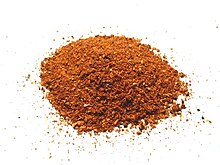| Aleppo pepper | |
|---|---|
 Aleppo pepper, in its typical processed form | |
| Species | Capsicum annuum |
| Origin | Aleppo, Syria |
| Heat |
|
| Scoville scale | 10,000 SHU |
The Aleppo pepper ( Arabic: فلفل حلبي, ALA-LC: fulful Ḥalabī; Turkish: Halep biberi) is a variety of Capsicum annuum used as a spice, particularly in Turkish, Middle Eastern and Mediterranean cuisine. Also known as the Halaby pepper, [1] its pods are ripened to a burgundy color, then semi-dried, de-seeded, and crushed or coarsely ground. [2] The pepper flakes are known in Turkey as pul biber (pul = flake, biber = pepper), and in Armenia as Halebi bibar. In Turkey, pul biber is the third most commonly used spice, after salt and black pepper. In Arabic, the pepper is named after Aleppo, a long-inhabited city along the Silk Road in northern Syria, and is grown in Syria and Turkey.
Although a common condiment, its use in Europe and the United States outside Armenian, Syrian and Turkish immigrant communities was rare until the 20th century, with one source ( Los Angeles magazine) dating its rise in use among the broader U.S. population according to the 1994 publication of The Cooking of the Eastern Mediterranean by Paula Wolfert. [3]
Characteristics
The Aleppo pepper has a moderate heat level of about 10,000 on the Scoville scale, [4] [5] with some fruitiness and mild, cumin-like undertones. Its flavor is similar to the ancho chile, but oilier and slightly salty; salt is often used in the drying process. [2] It is fairly mild, with its heat building slowly, with a fruity, raisin-like flavor. It has also been described as having the flavor of "sweetness, roundness and perfume of the best kind of sundried tomatoes, but with a substantial kick behind it". [6] Some renowned chefs prefer Aleppo pepper for its "fruity and bright qualities." [7]
Uses
The most common use is in the form of crushed flakes, which are typically slightly milder and oilier than conventional crushed red pepper, with a hint of saltiness and a slightly raisin-like flavor. Unlike crushed red pepper, the flakes contain no inner flesh or seeds, contributing to the mildness. Crushed Aleppo pepper can be used as a substitute for crushed red pepper or paprika.
The spice is a common ingredient in some of the dishes that comprise a meze. [8]
See also
References
- ^ "Chiles You Haven't Heard of but Soon Will". www.spicesinc.com. Retrieved 2018-08-28.
- ^ a b David Floyd (June 10, 2010). "The Aleppo Pepper". United Kingdom: The ChileFoundry. Archived from the original on 2010-12-23. Retrieved 2010-10-20.
- ^ "Hot Stuff". Los Angeles. Connoisseur Corner. May 2002. Archived from the original on 2010-02-27. Retrieved 2010-10-20.
- ^ "Aleppo Pepper: Silk Roads and Subpar Steaks". Riverfront Times. Spice World (blog). July 27, 2010. Archived from the original on 2010-10-01. Retrieved 2010-10-20.
- ^ "Pepper Heat Ratings in Scoville Units". Penzeys Spices. Archived from the original on 2010-02-27. Retrieved 2010-10-20.
- ^ "Bluefish and Aleppo Pepper". The New York Times (blog). Diner's Journal. June 27, 2008. Retrieved 2010-10-20.
- ^ "How Syria's Famous Aleppo Pepper Might Be Saved". National Geographic. 2016-04-05. Archived from the original on October 30, 2020. Retrieved 2020-10-04.
- ^ "Bank holiday special: A picnic with a twist". Metro. 27 April 2009. Retrieved 2010-10-20.